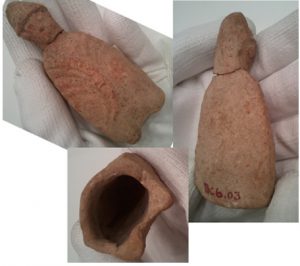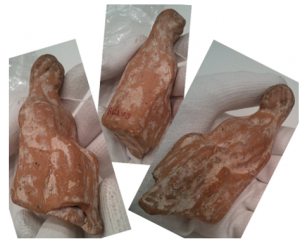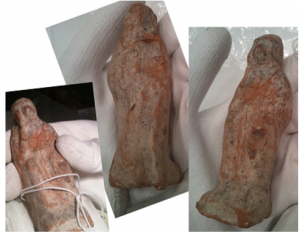A study of select items donated by Caroline Louise Ransom
When deciding on which objects to observe, I felt that it was necessary to include Greek antiquities that Caroline donated. Although her main concentration and interest was clearly Egyptology most of the objects she donated to Mount Holyoke were Classical antiquities. Therefore, I selected a group of three Tanagra Figurines found in Boeotia, located in central Greece, from her collection of donated items. I have grouped these three objects together for they are similar in size, shape, and material. I have had a lot of difficulty finding other Boeotian statues that are similar to these to use as reference or even compare for purpose, which led to my inconclusiveness which I find both interesting and disheartening.
Figurines
SEATED PAN

The Seated Pan is a terracotta figurine with traces of red paint. He is wearing a peaked hat and is wrapped in a himantion. He is broken and repaired at the neck and plain in the back. Because the bottom of the figure is missing, you can see that the figure is hollow, just as many Tanagra figurines are.
SEATED WOMAN

The Seated Woman is also a red clay figurine with traces of white paint. Her features are not very distinguishable, but it is clear that she is wearing a peplos and himantion and is seated distinctly in a throne with her hands on her lap. She is broken at the foot which shows that the figure is hollow.
SEATED MONKEY

The Seated Monkey caused many issues for me. I tried to find references to monkey figurines and even Tanagra monkeys, but found nothing. This figurine is also made of red clay with traces of white paint. This figure also appears to be draped and is holding its right hand up against its face with its left arm over his knees. Although I can see the resemblance to a monkey, I am convinced it is incorrectly catalogued because I cannot find any information about monkey figurines in Greece.
Scarabs
Scarabs are the native dung beetles in Egypt and are very common creatures with the humblest of occupations. They roll up excrements in which they nest or even consume as food. Because the Egyptians thought the scarabs to appear spontaneously from where they are born, they were often associated with the god of creation, Atum. They were also revered in Egypt for one myth conceives the Sun-god to be a giant beetle that rolls the sun across the sky. Scarabs were used often for decoration as well as symbolic purposes. This scarab is made of steatite with traces of a bluish-green glaze. The design is the name of Tuthmose III, Menkheperre with signs that translate to “the good god,” an honorific title of the king. There is slight damage, but I chose this scarab because it is the only one that had just elaborate detail on the outside of it. Like all the other scarabs I have chosen, this scarab is hollow in the middle as a bead would be.
Also made of steatite, this scarab has the design of a crocodile and crouching antelope. I had difficulty finding the correlation between the two animals. Satis, the goddess of fertility, is depicted as a woman with antelope horns. Ammut, “Devourer of the Dead” is part crocodile, hippopotamus, and lion. Therefore, I have concluded that the antelope represents birth and the crocodile represents death.
This scarab is made of steatite with the design on a striding horse and the cartouche, an oval with a horizontal line at one end which represents a royal name, reading “Menkheperre”. Above the horse is the hieroglyph nefer meaning “good” or “beautiful.” Horses were first introduced to Egypt in the Hyksos Period and are frequently featured on scarabs from the eighteenth dynasty and often symbolize a king (in this case, Tuthmosis III).
This gold scarab shows a stylized lotus blossom. Because the lotus blossom closes at night and sinks underwater and emerges and blooms in the morning, it became the symbol of the sun and creation. This scarab was the mount of a signet ring. In earlier periods, Egyptians used cylinder seals that were much too large to be worn on the finger and were usually suspended on a cord or string of some sort. The signet ring came before 2000 B.C. and was worn as both ornament and as a seal. They often served as marks of authority and the lotus flower is one of the popular designs that were used. You can distinguish this scarab to be the mount of a signet ring because of the extended tubular end which attached to a hoop that allowed the scarab to be a type of swivel mount.
Although this scarab is made of light gray steatite, it greatly resembles wood. The symbols on the scarab translate as “Wennefer lord.” Wennefer, also known as Parennefer, was the High Priest of Amun during the reign of Tutankhamen and Horemheb. He was the son of Minhotep and Maia and the husband of Isis.
The design on this scarab made of blue-glazed steatite is of a uraeus cobra and a winged sphinx. The uraeus cobra is used as a symbol of royalty. Unlike in Greek mythology, the sphinx was thought of as a guardian in Egyptian tradition and was often in the entrances of temples.
Refer to Image Gallery for visual reference